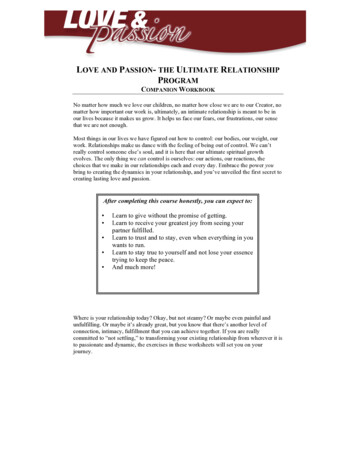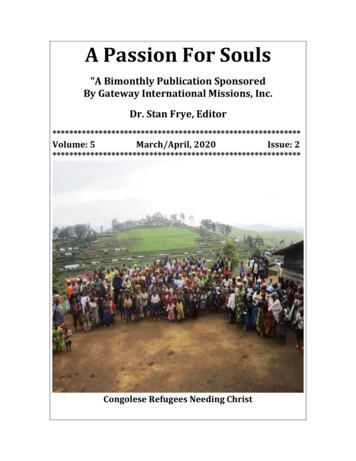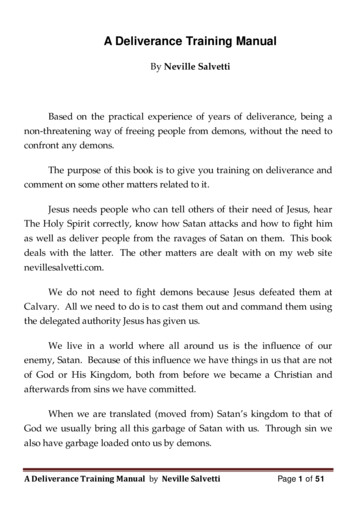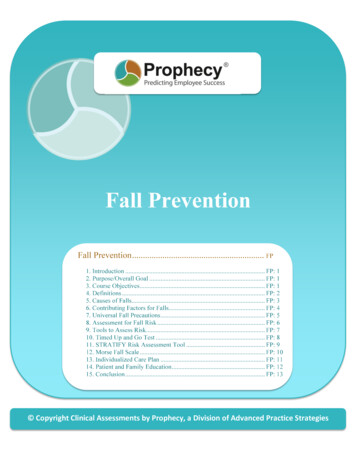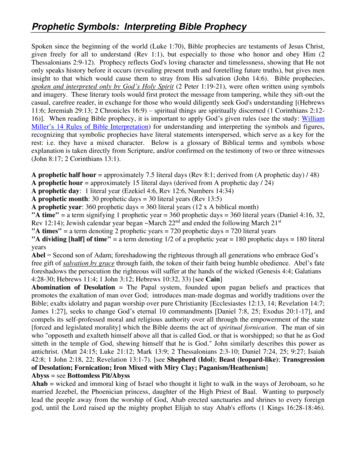
Transcription
1When Prophecy Became Passion:The Death of Jesus and the Birth of the GospelsMark GoodacreIntroductionLook at all my trials and tribulationsSinking in a gentle pool of wineWhat’s that in the bread, it’s gone to my headTill this morning is this evening life was fine.So runs the crass but catchy refrain of the disciples as they sit down with Jesusat the Last Supper in the musical Jesus Christ Superstar. They continue:Always hoped that I’d be an apostleKnew that I could make it if I triedThen when we retire we can write the GospelsSo they’ll all talk about us when we’ve died.Now as anyone acquainted with any Biblical scholarship will know, there areso many questionable assumptions in this chorus that one can hardly decidewhere to begin. Of the four canonical Gospels, only two bear the names ofapostles; none are thought to be written by eye-witnesses, and the centre ofattention in the Gospels is, of course, not the apostles but Jesus.
2And yet this rather unpromising starting point has a striking and unexpectedconnection with our topic:how were the Gospels born?What was thecatalyst for the creation of these extraordinary new pieces of literature? Whydid the early Christians begin forging individual traditions about Jesus intolarge scale narrative biographies?For all that is bizarre about Tim Rice’sformulation just quoted, it gets one very important thing right: the LastSupper as a focal point, and the notion that there is something significantabout it that might help us to understand how the Gospels emerged onto thescene.1. Earliest Christian TraditionOur journey, then, begins here, at Jesus’ last meal with his disciples on the eveof his crucifixion. The earliest known tradition of Jesus’ life story is a versionof the Last Supper. It is one of the best attested features of Jesus’ life and itoccurs when the apostle Paul, writing within twenty years of the event he isretelling, reminds the recipients of one of his first letters, the church atCorinth, of the tradition about Jesus’ Last Supper.Paul’s letters areoccasional, written in response to particular difficulties arising in the churcheshe had founded, and we can be grateful to the Corinthians for having arguedabout the Lord’s Supper because it provides Paul with the occasion not onlyto give us his own teaching about sharing in this ritual but also to underline
3this teaching with a reminder of the origins of the eucharist. In the night thathe was handed over, Paul tells the Corinthians, he took bread, and when he hadgiven thanks, he broke it and said, ‘This is my body which is for you . . . . (1 Cor.11.23-24). The passage is striking because it demonstrates that from veryearly on, tradition and memory were playing key roles.remembrance of me, Jesus says (11.24).Do this inPaul keeps the memory alive as,presumably, other early Christians did too by passing on the tradition: for Ireceived from the Lord that which I also handed on to you (11.23). And there is atheological reason for the pattern of repeating and retelling: to do this is tofulfil the command of Jesus and to identify with his sufferings, proclaimingafresh Jesus’ death until he returns (11.26).But does this story witness to anything more than an early Christianunderlining of the importance of the tradition, memory and eucharist? Well,there is a fascinating detail here that it is easily overlooked.What isinteresting is the way in which Paul introduces the eucharistic words. Hesays in the night that he [Jesus] was handed over (11.23). Sometimes in historyyou can find out interesting things by observing what a writer thinks his orher readers can take for granted. Paul here apparently assumes that the timenote, the night that he was handed over, would be understood by his hearers.“O, that night”; not any other night, not any ordinary night. It is a note that
4hints that his hearers knew a good deal more of this story than Paul has timeor need to share here. The Corinthians, we must assume, are familiar withsome kind of narrative of Jesus’ last days.But is there any more that we can go on than this? Can we be sure that theCorinthians knew more than just these few details? Well, we are lucky thatthe Corinthians were a pretty dissentious lot and not only were questionsbeing asked in Corinth about the eucharist, but also they were getting askedabout resurrection. So Paul has the opportunity to expand on traditions aboutthe resurrection and in 1 Cor. 15, he provides a short Easter narrative,recounting, in sequence, an appearance to Peter, then the twelve, then Jamesthe Lord’s brother, then all the apostles, then five hundred people and finally“as to one untimely born” to Paul himself. We have, then, in 1 Corinthianstwo very important snap-shots, one of the narrative about the eucharist, onthe eve of Jesus’ crucifixion and so towards the beginning of the PassionNarrative, and one of the narrative about the resurrection, at the culminationof the Passion Narrative. The difficulty with snap-shots, though, is that theyleave us longing for more. [We’d love to see the home movie] What else didthe earliest Christians narrate about Jesus’ Passion? How did they tell it?And what began the process?
5Once again, a closer look at 1 Corinthians proves illuminating. Paul beginsthe passage on the resurrection (1 Cor. 15) as he had earlier begun the passageon the eucharist (1 Cor. 11.23-26), by stressing tradition. Paul says that he is“passing on” to the Corinthians that which he has also received, and, he says,this material is of first importance (1 Cor. 15.3).Now as he begins hisnarration of these crucial events, he lists several key things, all linked with theword that (ὅτι) almost as we might construct a bullet-point list: that Christ died for our sins according to the Scriptures that he was buried that he was raised on the third day according to the ScripturesThere is a twice recurring feature here that looks very interesting: according tothe Scriptures. Paul, and the tradition he has received, are clearly stressing thiselement. The theological drive at the heart of this conviction is not difficult tofathom, especially for early Christians eager to persuade others that theapparent scandal of a crucified Messiah, a criminal at the heart of their newfaith, was in fact prophesied in the Scriptures – he was, in other words, rightat the heart of God’s plan for the world and not an embarrassing mistake.That this was indeed a key feature in the development of the PassionNarrative is confirmed when we turn to the evidence of the Gospels. Here, on
6line after line, we have direct quotations, echoes of and allusions to theHebrew Bible – its very texture dominates the accounts. The psalms andIsaiah are particularly frequently found. Just think, for example, of Jesus’silence at his trials. What better example could there be of someone fulfillingIsaiah’s prophecy that he would be silent before his accusers? Or considerJesus’ words from the cross in Mark and Matthew, “My God, my God, whyhave you forsaken me”, as clear an allusion to Psalm 22.1 as one could wishfor.2. Prophecy Historicized or Tradition Scripturalized?It seems clear that from early on the Scriptures played a pivotal role inChristian propaganda. Indeed for some scholars the role is so major thatthere is something a little fishy. Could it really have been that the pattern ofJesus’ life and death adhered so closely to the Scriptural models andantecedents, and in such detail? What I would like to explore on the next partof our journey is the role played by the Scriptures in the Passion Narrativewith a view to revealing something very interesting about the origins of thatnarrative. In order to do this, we will need to take a moment to look at aparticularly influential current theory from John Dominic Crossan.Crossan, who has published extensively on the Passion Narratives, is acutelyaware that to explain their origins will demand finding an adequate account
7of the role played by the Scriptures there. The term he uses to describe howthe Passion Narratives came about is the suggestive one prophecy historicized.He explains the phenomenon like this:“The individual units, general sequences, and overall frames of thepassion-resurrection stories are so linked to prophetic fulfillment thatthe removal of such fulfillment leaves nothing but the barest facts,almost as in Josephus, Tacitus or the Apostles’ Creed . . . . In otherwords, on all three narrative levels – surface, intermediate and deep –biblical models and scriptural precedents have controlled the story tothe point that without them nothing is left but the brutal fact ofcrucifixion itself.”1Several important elements in Crossan’s approach make it worthy of specialattention. It is a mark of Crossan’s skill as a communicator that he is able toencapsulate his thesis in one aptly chosen term and that his use of this term,prophecy historicized, has generated fresh interest in the origins of thePassion Narrative. Further, like many of the best teachers Crossan makes hispoint by means of contrast, placing his own view at one pole and thealternative view, that the Passion Narratives are history remembered, at the1John Dominic Crossan, The Birth of Christianity: Discovering What Happened inthe Years Immediately After the Execution of Jesus (Edinburgh: T & T Clark, 1998):521.
8other pole.This “history remembered” view he attributes to RaymondBrown2 and he characterises it like this:“Jesus’ companions knew or found out what happened to him, andsuch historical information formed the basic passion story from thevery beginning. Allusions to biblical precedents were illustrative orprobative for that story, but not determinative or constitutive of itscontent. Maybe, from all the details known to them, they chose thosethat fitted best with such biblical precedents, but in general it washistory and not prophecy that determined narrative sequence andstructure.”3In Who Killed Jesus?, Crossan uses the Darkness at High Noon (Matt. 27.45 //Mark 15.33 // Luke 23.44 // Peter 5.15, 6.22) as his primary illustration of howthat explanation would work. He writes :“To explain those accounts as ‘history remembered’ means that Jesus’companions observed the darkness, recorded it in memory, passed it2Raymond E. Brown, The Death of the Messiah: From Gethsemane to the Grave: ACommentary on the Passion Narratives in the Four Gospels (2 vols.; Anchor BibleReference Library; New York: Doubleday, 1994).3Crossan, Birth of Christianity: 520.
9on in tradition, and recalled it when writing their accounts of thecrucifixion. It happened in history, and that is why it is mentioned ingospel.”4The explanation of “prophecy historicized”, on the other hand, involvesreading the Gospel accounts alongside Amos 8.9-10, which speaks of the dayof the Lord when God promises to “make the sun go down at noon anddarken the earth in broad daylight.” “I will make it like the mourning for anonly son,” He says, “and the end of it like a bitter day.” And then, Crossanexplains:“By ‘prophecy historicized’ I mean that no such historical three-hourlong midnight at noon accompanied the death of Jesus, but thatlearned Christians searching their Scriptures found this ancientdescription of future divine punishment, maybe facilitated by itsmention of ‘an only son’ in the second-to-last line, and so created thatfictional story about darkness at noon to assert that Jesus died infulfillment of prophecy.”54John Dominic Crossan, Who Killed Jesus? The Roots of Anti-Semitism in theGospel Story of the Death of Jesus (San Francisco: HarperSanFrancisco, 1995): 2.5ibid.: 4.
10I have spent a little time explaining Crossan’s thesis because many haveapparently found it persuasive and it has reached a wide public throughseveral best-selling books and through the advocacy of the Jesus Seminar,who when they came to vote on the Passion Narrative agreed that prophecyhistoricized is indeed the best explanation for its origin.6 But that is not theonly reason for spending time looking at Crossan’s view. It is importantbecause he is taking seriously the role played by prophecy in the PassionNarrative. The Hebrew Bible was simply too important a resource for theearliest Christians for it not to have been utilised in a thoroughgoing way.Whatever one thinks of his answers, Crossan is asking the right questions.I would like to suggest, however, that a different and more plausible answerto these questions is available. We should be put on our guard, to begin with,by the severity of the contrast Crossan sets up between his own view and thatof Raymond Brown, between prophecy historicized and history remembered.6See, for example, Daryl D. Schmidt’s endorsement of the thesis in“Septuagintal Influence in the Passion Narratives”, Forum New Series 1.1(Spring 1998): 95-118, especially 107. Cf. Marcus Borg’s use of Crossan’sterms in N. T. Wright and Marcus Borg, The Meaning of Jesus: Two Visions(London: SPCK, 1999): 84-5. The Jesus Seminar overall finds the thesispersuasive. The proposition “Detailed information about the crucifixion ofJesus is derived from prophecy historicized” receives a “red” rating, “TheJesus Seminar: Voting Records: The Passion Narrative”, Forum New Series 1.1(Spring 1998): 227-33 (230).
11The reader is presented with a choice: is it history or is it prophecy? Did ithappen or is it fictional? The contrast between the two views presented issimply too stark. Given these sole alternatives, history remembered or prophecyhistoricized and given the undisputed level of Scriptural allusion in the PassionNarratives, few critical scholars would be able to resist Crossan’s conclusion.But the choice offered by Crossan is not a necessary one. Only the mostardent fundamentalists would go for the view that the Passion Narrativeswere simply made up of “history remembered”, and the term is in fact notone that is used by Raymond Brown, whose work Crossan is effectivelycaricaturing.7But there is a more nuanced alternative available and it might be explainedlike this. The multiple echoes of Biblical themes and the varied allusions toScriptural precedent are plausibly explained on the hypothesis that from thebeginning there was an intimate interaction between event, memory, traditionand Scriptural reflection. Events generated Scriptural reflection, which in turninfluenced the way the events were remembered and retold. And the process7Although Brown does indeed see the “basic incidents” of the PassionNarrative as derived from “early Christian memory” (Death of the Messiah: 16),he also sees the whole process, from eye-witness and “ear witness” through tothe evangelists, as involving embellishment from the Christian imagination(for example Death of the Messiah: 14).
12of casting the narrative in this language might be described, to utilise asomewhat cumbersome but nevertheless illuminating term from HebrewBible scholarship, scripturalization. This term is used by Judith Newman ofJewish prayers in the Second Temple Period, which increasingly usedScriptural models, precedents and language.8 The thesis of Newman’s book isthat increasing devotion to developing Jewish Scriptures, in a liturgicalcontext in which such Scriptures were getting used more and more, ledinexorably to the intermingling of those Scriptures with Jewish prayers. It is aview that could shed some very interesting light on the Passion Narratives inthe Gospels.In order to see the phenomenon of scripturalizing at work, and to assesswhether it has any better explanatory power than does “prophecyhistoricized”, it will be useful to take a closer look at an element in the PassionNarrative, ideally one that tends to be securely regarded as history. Let usturn, therefore, to one of the very few details in the Passion Narrative whichCrossan regards as historical, the note in Mark 15.40-41 of the women8Judith H. Newman, Praying by the Book: The Scripturalization of Prayer inSecond Temple Judaism (Atlanta: Scholars Press, 1999).
13watching the crucifixion from a distance,9 and then let us take a closer look.Crossan attempts to disentangle tradition from Markan redaction and writes:“Their existence and names in 15.40-41 are pre-Markan tradition, buttheir criticism in 15.47—16.8 is Markan redaction. In other words, theinclusion of women observing the burial and visiting the tomb is noearlier than Mark, but the inclusion of women watching thecrucifixion is received tradition. But is the latter historical fact? Mybest answer is yes, because the male disciples had fled; if the womenhad not been watching, we would not know even the brute fact ofcrucifixion (as distinct, for example, from Jesus being summarilyspeared or beheaded in prison).”10Now the example is an interesting one for two reasons.First, Crossan’sremark that “the male disciples had fled” and so could not have provided9In favour of the historicity of this detail, Gerd Theissen points out that thenames given here appear to presume the readers’ knowledge of their identity,The Gospels in Context: Social and Political History in the Synoptic Tradition (ET,Edinburgh: T & T Clark, 1992): 177-8. See Chapter 4 overall for a finediscussion of the origins of the Passion Narrative. For Crossan’s discussion ofTheissen, see Birth of Christianity: 504-5.10Birth of Christianity: 559. See also Who Killed Jesus?: 181-5 for reflections onthe role played by the women in the story. In The Historical Jesus: The Life of aMediterranean Jewish Peasant (San Francisco: HarperSanFrancisco, 1991): 415,Crossan suggests that the first version of Mark originally ended just beforethese verses, at 15.39, the Centurion’s Confession.
14details of the crucifixion is curious.11How do we know that the maledisciples had fled? What is the source of our information for this detail, sokey an assumption in Crossan’s case? The detail is found in Mark 14.50,“Everyone deserted him and fled”, where it follows directly from Jesus’announcement in 14.49, “Let the scriptures be fulfilled”. And the scripture inview here is clearly Zechariah 13.7, “Strike the shepherd and the sheep will bescattered”, quoted by Jesus in Mark 14.27, where Jesus predicts the fallingaway of the disciples. But if this key foundational detail is itself so explicitlyScriptural, Crossan’s model demands that we see this too as “prophecyhistoricized”.And if this detail is prophecy historicized, how – to useCrossan’s logic – can we trust it as history? If we cannot trust the historicityof this element, there is no obligation to accept the absence of the disciples asa foundational premise for the whole. In other words, without the knowledgethat there was no one present at the crucifixion, we do not require the thesisof the inevitability of the “prophecy historicized” model.Second, the wording of the verse in question is noteworthy:‘And there were also women watching from a distance (ἀπὸ11See the quotation above, Birth of Christianity: 559.
15μακρόθεν)’ (Mark 15.40; cf. Matt. 27.55 // Luke 23.49).The note that they were watching “from a distance”12 echoes the wording ofPsalm 38.11 LXX, “My friends and companions stand aloof from my affliction,and my relatives stand from a distance (ἀπὸ μακρόθεν)”. It is one of thosedetails that virtually every commentator on the passage mentions.13 What wehave here is an element with a strong claim to be historical getting expressedin language derived from the psalms. It is not as if the women’s witness hasbeen created on the basis of Psalm 38.11, which does not refer solely towomen, let alone to those particular named women. Rather, the traditionalelement is being remembered and retold in the light of the Scriptural passagethat was thought to be fulfilled. In other words, in this verse we see the exact12Contrast John 19.25-27 where the Beloved Disciple and Jesus’ mother areclose enough to hold a conversation with Jesus. Joel Marcus, “The Role ofScripture in the Gospel Passion Narratives”, in John T. Carroll and Joel B.Green (eds.), The Death of Jesus in Early Christianity (Peabody, MA:Hendricksons, 1995): 205-33 speculates that the Johannine account “may bemore accurate historically than the Synoptics” in view of the fact that“Romans often allowed friends of crucified criminals to stand by them untilthey died” (212). But on this point contrast Brown, Death of the Messiah: 1029and 1194, “it would be unusual for the Romans to permit family andsympathizers such proximity”.13Brown, Death of the Messiah, Volume 2: 1158. Kathleen E. Corley, “Womenand the Crucifixion and Burial of Jesus”, Forum New Series 1.1 (Spring 1998):181-226, notes that “Luke reinforces this connection with Psalm 38.11 by theaddition of οἱ γνωστοί (friends) (Luke 23.49)”: 212, n. 211. Her full discussionof the passage, with some useful bibliography is on 209-17.
16opposite of the process of “prophecy historicized”. An historical traditionbeen expressed using the terminology of the scriptures. Or, we might say, thetradition was scripturalized.Yet even the suggestive term scripturalization does not solve all the problemswith the Passion Narrative. Like Crossan’s “prophecy historicized” it hints atsomething too one directional. Though helpful, it might give the impressionof a neutral, un-interpreted raw event that has been given an interpreted,scripturalized overlay, something that is over simplistic and unrealistic.Perhaps, then, we should think instead of a creative interaction between thedifferent elements, an interaction that began at the start. Consider, forexample, that anguished cry from the cross, “My God, my God, why haveyou forsaken me”. It seems unlikely that this was invented by Mark, inwhose Gospel it first appears, not least in that it is given in an Aramaicversion as well as Greek and in that the bystanders are all depicted as failingto understand it. Yet other elements in the same crucifixion story also bearstriking resemblances to Psalm 22 too, such as the casting of lots for Jesus’garments, elements that are much less securely regarded as history. What Isuggest is happening here is that the events themselves were generatingscriptural reflection from the earliest times as the first Christians attempted tocome to terms with these extraordinary events, and that the scriptures then, in
17turn, influenced the formation of the tradition.It was an interactive processin which history, scripture, memory and tradition were mutually influencingone another as the narrative was being born.3. The Passion as LiturgyIn our search for Gospel origins, we have discovered the importance ofrecognising the interaction between scripture and tradition, and seeing thePassion Narrative as a major location for this activity. But when did thisprocess begin and how did it happen?interaction?What was the context for thisAre we talking about scribes debating in synagogues, earlyChristians telling stories at dinner parties, philosophical discussions in themarket place? I don’t think that it is any of these, at least not primarily. Thesocial context that gave birth to the forging of narrative materials about thePassion was the church service, worship, the liturgy. How can we know this?Well, think back for a moment to our beginning point, the disciples at the LastSupper and Paul’s account of that first eucharist in 1 Corinthians.Paul,remember, is retelling the Corinthians that story in the context of theirinability to behave properly in their own worship. As early as our evidencetakes us, we have liturgy as the context in which the retelling of the story, andwhat’s more a connected story, appears. What we have, in other words, is aliturgical context for the earliest known narration of the events in Jesus’Passion. Could it be that we have further evidence anywhere else of the
18telling of the Passion Story in the liturgy?Indeed we have: there is somevery telling circumstantial evidence from within the Gospels themselves.The evidence looks like this and it is something we have already begun toencounter, the darkness that engulfed the earth at noon. Remember that forCrossan, this is explained on the basis of a prophecy, Amos 8.9, gettinghistoricized. This is a good example of the limitations of that model since allthat Amos 8.9 is able to explain is, at best, one element in the story – thedarkness at midday. But this time reference is one of many in the PassionNarrative and they all have one thing in common: they happen at three hourintervals. The darkness that comes over the earth at 12 lasts three hours until3 p.m., when Jesus dies (Mark 15.33-4). Before the darkness begins, Jesus hasalready been on the cross for three hours, since 9 a.m. (Mark 15.25). Beforethat, Jesus was brought before Pilate at dawn, 6 a.m. (Mark 15.1, πρωΐ). Nordoes the pattern stop there. There appears to be something like a twenty-fourhour framework, broken up neatly into three hour segments. Thus, if weimagine the Last Supper taking place at 6 p.m. (14.17, “When it was evening . .”), Jesus and the disciples would then go to Gethsemane at 9 p.m.,14 Jesus14Mark 14.37-41: “Could you not watch one hour? . . . . again he came . . . andhe came the third time . . . . the hour has come”
19would be arrested at midnight, and Peter denies Jesus during the Jewish trialat 3 a.m., cockcrow (14.72).Nor is it simply that these stories fit nicely into this schedule. Individual unitsthemselves seem to be patterned in such a way that they reflect this kind ofstructure. Jesus in Gethsemane asks his disciples to watch with him and isdistressed that they could not stay awake for “one hour” (14.37), and thentwice again he comes to them (14.40-1). And then, similarly, Peter deniesJesus three times at cockcrow, the Roman watch at 3 a.m. (14.54, 66-72)Explanations for this marked three-hour structure that so dominates thePassion Narrative have not, on the whole, been forthcoming. The difficulty is,of course, that life is not quite as neat and tidy as this – events do not happenin even three hour units. That the pattern is intentional and in some waysignificant seems to be confirmed by a saying of Jesus located just before thebeginning of Mark’s Passion Narrative:“Therefore keep watch because you do not know when the owner ofthe house will return – whether in the evening, or at midnight, orwhen the cock crows, or at dawn. If he comes suddenly, do not let
20him find you sleeping. What I say to you, I say to everyone: ‘Watch!’”(Mark 13.35-37).The text itself appears to be drawing attention to the three hour pattern,alerting the bright reader to what is to come. And though an explanation hasbeen put forward separately by three different scholars, a Canadian (PhilipCarrington) in the 1950s,15 an Englishman (Michael Goulder) in the 1970s,16and a Frenchman (Étienne Trocmé) in the 1980s,17 it is still hardly known at allin mainstream scholarship.18 These three scholars claim that the liturgy is theonly thing that would make sense of this. What is happening, they suggest, isthat the early Christians were holding their own annual celebration of theevents of the Passion at the Jewish Passover, remembered as roughly the timeof Jesus’ death. While other Jews were celebrating Passover, Christian Jewsheld a twenty-four hour vigil in which they retold and relived the eventssurrounding Jesus’ arrest and death, from (what modern Christians would15Philip Carrington, The Primitive Christian Calendar: A Study in the Making ofthe Marcan Gospel (Cambridge: Cambridge University Press, 1952).16Michael Goulder, Midrash and Lection in Matthew (London: SPCK, 1974) andThe Evangelists’ Calendar (London: SPCK, 1978).17Étienne Trocmé, The Passion as Liturgy: A Study in the Origin of the PassionNarratives in the Four Gospels (London: SCM, 1983).18However for recent, relatively sympathetic comments see D. Moody Smith,“When did the Gospels become Scripture”, JBL 119 (2000): 3-20 (5-6).
21call) Maundy Thursday at 6 p.m. to Good Friday at 6 p.m. Perhaps Mark’saccount of the Passion, with its heavy referencing of Scripture, its regular timenotes, was itself influenced by such a liturgical memory of the Passion.Now this theory remains precisely that, a theory, but like all the best theories,this one has explanatory power – it is able to shed light on several otheroddities in the Passion Narrative, elements that have consistently eluded thecommentators: The date of Jesus’ death. There is a famous contradiction here. Is John rightthat this was on the day before Jewish Passover, when the paschal lambswere being slaughtered (14 Nisan), or are the Synoptics right that Jesusdied at the feast of Passover itself (15 Nisan)? The liturgical theory wouldsuggest that the disagreement is not so much over which day, historically,Jesus actually died on, but on which day it was celebrated andremembered by early Christians. And the fact that there was a big debatein the second century over precisely this question, when to rememberJesus death, with the Quartodecimans in Asia controversially taking the
22Johannine view while others took the Synoptic view, is suggestive for thistheory.19 The time of the crucifixion: was it at 9 a.m. (the Synoptics), with darknesscoming over the earth at 12 p.m.; or was it at 12 p.m. (John)? Again, theliturgical theory would shed light.The disagreements were betweenJohannine Christians who remembered the crucifixion at one time andothers who remembered it at the other time.The actual memory of thetime of Jesus’ crucifixion has effectively been lost and the liturgy is pullingthe events into contexts that have more to do with the time at which theywere celebrated than anything else. The rushed timetable: it has always been a problem to try to understand whythe timetable of Jesus’ last hours appears to be so rushed. Why did theJewish authorities hold a trial in the middle of the night? Why are somany of the characters in the narrative so eager to have Jesus crucified ona festival (or the eve of a festival)?
2 Raymond E. Brown, The Death of the Messiah: From Gethsemane to the Grave: A Commentary on the Passion Narratives in the Four Gospels (2 vols.; Anchor Bible Reference Library; New York: Doubleday, 1994).
